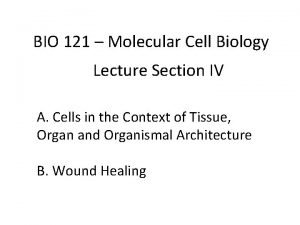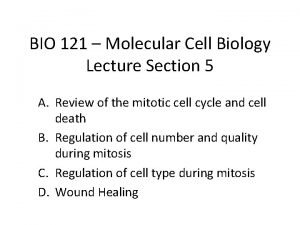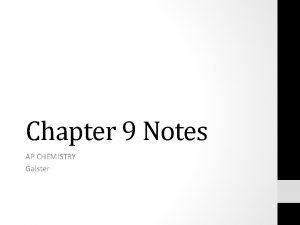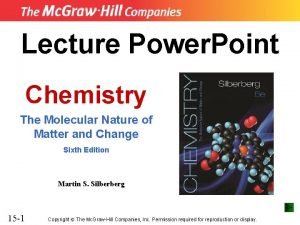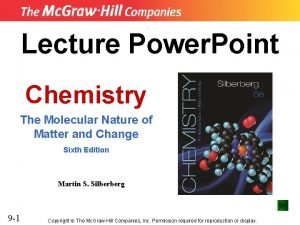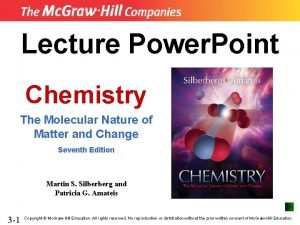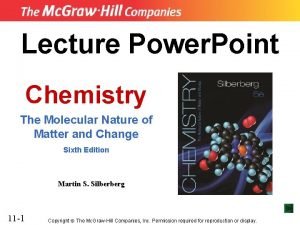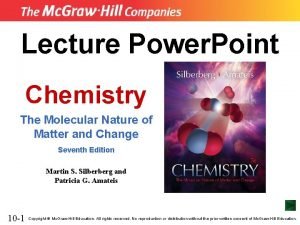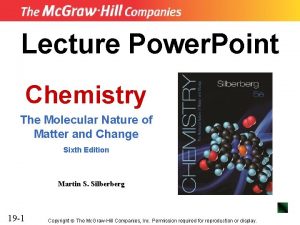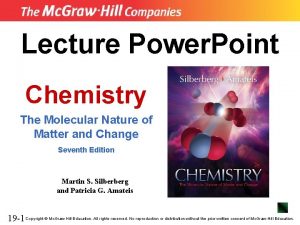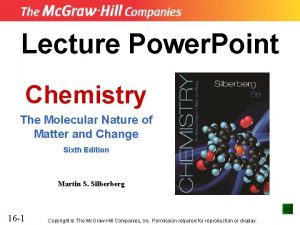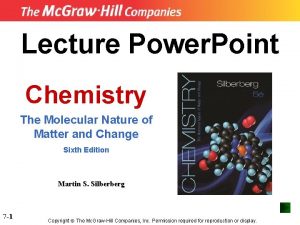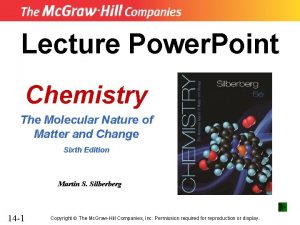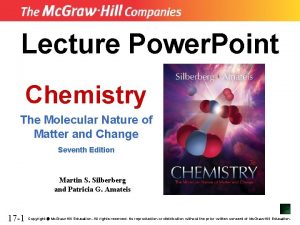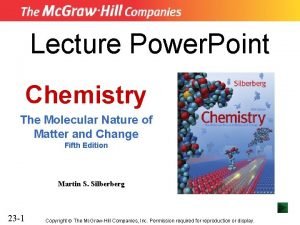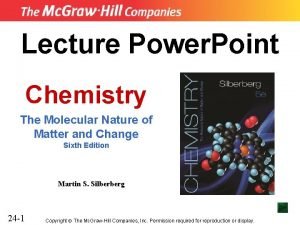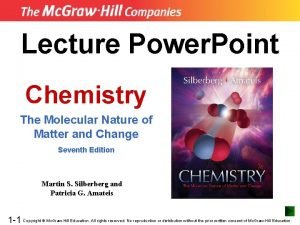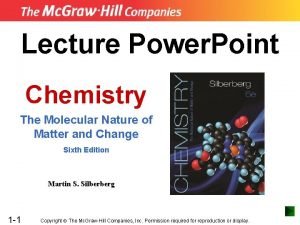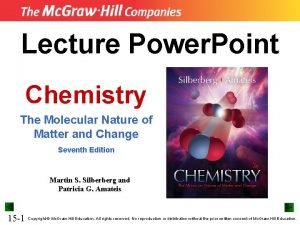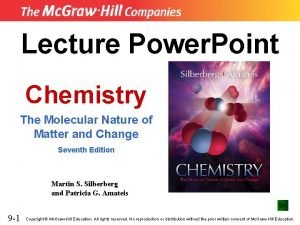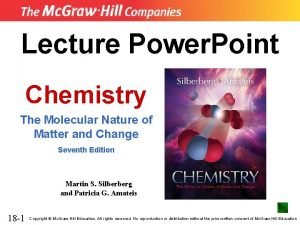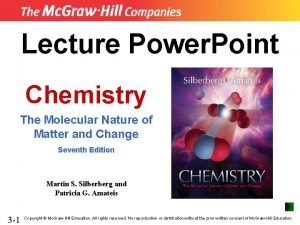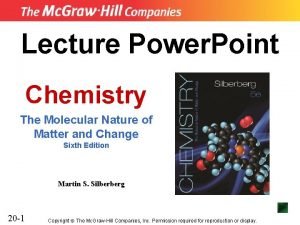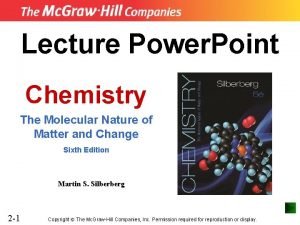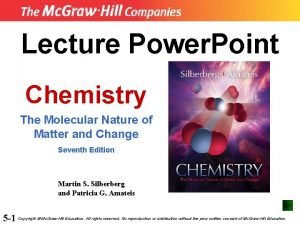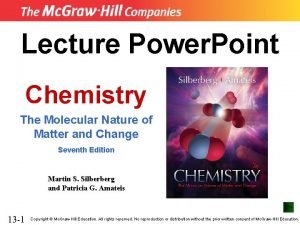Lecture Power Point Chemistry The Molecular Nature of
















































- Slides: 48

Lecture Power. Point Chemistry The Molecular Nature of Matter and Change Seventh Edition Martin S. Silberberg and Patricia G. Amateis 20 -1 Copyright Mc. Graw-Hill Education. All rights reserved. No reproduction or distribution without the prior written consent of Mc. Graw-Hill Education.

Chapter 20 Thermodynamics: Entropy, Free Energy, and the Direction of Chemical Reactions 20 -2

Thermodynamics: Entropy, Free Energy, and the Direction of Chemical Reactions 20. 1 The Second Law of Thermodynamics: Predicting Spontaneous Change 20. 2 Calculating Entropy Change of a Reaction 20. 3 Entropy, Free Energy, and Work 20. 4 Free Energy, Equilibrium, and Reaction Direction 20 -3

Spontaneous Change A spontaneous change is one that occurs without a continuous input of energy from outside the system. All chemical processes require energy (activation energy) to take place, but once a spontaneous process has begun, no further input of energy is needed. A nonspontaneous change occurs only if the surroundings continuously supply energy to the system. If a change is spontaneous in one direction, it will be nonspontaneous in the reverse direction. 20 -4

The First Law of Thermodynamics Does Not Predict Spontaneous Change Energy is conserved. It is neither created nor destroyed, but is transferred in the form of heat and/or work. DE = q + w The total energy of the universe is constant: DEsys = −DEsurr or DEsys + DEsurr = DEuniv = 0 The law of conservation of energy applies to all changes, and does not allow us to predict the direction of a spontaneous change. 20 -5

DH Does Not Predict Spontaneous Change A spontaneous change may be exothermic or endothermic. Spontaneous exothermic processes include: • freezing and condensation at low temperatures, • combustion reactions, • oxidation of iron and other metals. Spontaneous endothermic processes include: • melting and vaporization at higher temperatures, • dissolving of most soluble salts. The sign of DH does not by itself predict the direction of a spontaneous change. 20 -6

Figure 20. 1 A spontaneous endothermic chemical reaction. Ba(OH)2· 8 H 2 O(s) + 2 NH 4 NO 3(s) → Ba 2+(aq) + 2 NO 3–(aq) + 2 NH 3(aq) + 10 H 2 O(l) DH°rxn = +62. 3 k. J water This reaction occurs spontaneously when the solids are mixed. The reaction mixture absorbs heat from the surroundings so quickly that the beaker freezes to a wet block. 20 -7

The Second Law of Thermodynamics The sign of DS for a reaction does not, by itself, predict the direction of a spontaneous reaction. If we consider both the system and the surroundings, we find that all real processes occur spontaneously in the direction that increases the entropy of the universe. For a process to be spontaneous, a decrease in the entropy of the system must be offset by a larger increase in the entropy of the surroundings. 20 -8

Freedom of Particle Motion All spontaneous endothermic processes result in an increase in the freedom of motion of the particles in the system. solid → liquid → gas crystalline solid + liquid → ions in solution less freedom of particle motion more freedom of particle motion A change in the freedom of motion of particles in a system is a key factor affecting the direction of a spontaneous process. 20 -9

The Third Law of Thermodynamics A perfect crystal has zero entropy at absolute zero. Ssys = 0 at 0 K A “perfect” crystal has flawless alignment of all its particles. At absolute zero, the particles have minimum energy, so there is only one microstate. 20 -10

Standard Molar Entropies S° is the standard molar entropy of a substance, measured for a substance in its standard state in units of J/mol·K. The conventions for defining a standard state include: • 1 atm for gases • 1 M for solutions, and • the pure substance in its most stable form for solids and liquids. 20 -11

Factors Affecting Entropy • Entropy depends on temperature. – For any substance, S° increases as temperature increases. • Entropy depends on the physical state of a substance. – S° increases as the phase changes from solid to liquid to gas. • The formation of a solution affects entropy. • Entropy is related to atomic size and molecular complexity. – Remember to compare substances in the same physical state. 20 -12

Figure 20. 6 A Visualizing the effect of temperature on entropy. Computer simulations show each particle in a crystal moving about its lattice position. Adding heat increases T and the total energy, so the particles have greater freedom of motion, and their energy is more dispersed. S therefore increases. 20 -13

Figure 20. 6 B Visualizing the effect of temperature on entropy. At any T, there is a range of occupied energy levels and therefore a certain number of microstates. Adding heat increases the total energy (area under the curve), so the range of occupied energy levels becomes greater, as does the number of microstates. 20 -14

Figure 20. 7 20 -15 The increase in entropy during phase changes from solid to liquid to gas.

Figure 20. 8 The entropy change accompanying the dissolution of a salt. Copyright © The Mc. Graw-Hill Companies, Inc. Permission required for reproduction or display. pure solid MIX pure liquid solution The entropy of a salt solution is usually greater than that of the solid and of water, but it is affected by the organization of the water molecules around each ion. 20 -16

Figure 20. 10 20 -17 The entropy of a gas dissolved in a liquid.

Entropy and Atomic Size S° is higher for larger atoms or molecules of the same type. Li Atomic radius (pm) 152 Na K Rb Cs 186 227 248 265 Molar mass (g/mol) 6. 941 22. 99 39. 10 85. 47 132. 9 S°(s) 29. 1 51. 4 64. 7 69. 5 85. 2 HF HCl Molar mass (g/mol) S°(s) 20 -18 20. 01 173. 7 36. 46 186. 8 HBr 80. 91 198. 6 HI 127. 9 206. 3

Entropy and Structure For allotropes, S° is higher in the form that allows the atoms more freedom of motion. S° of graphite is 5. 69 J/mol·K, whereas S° of diamond is 2. 44 J/mol·K. For compounds, S° increases with chemical complexity. S°(s) S°(g) Na. Cl Al. Cl 3 72. 1 167 P 4 O 10 NO NO 2 N 2 O 4 211 240 304 229 These trends only hold for substances in the same physical state. 20 -19

Figure 20. 11 20 -20 Entropy, vibrational motion, and molecular complexity.

Sample Problem 20. 1 Predicting Relative Entropy Values PROBLEM: Choose the member with the higher entropy in each of the following pairs, and justify your choice [assume constant temperature, except in part (e)]: (a) 1 mol of SO 2(g) or 1 mol of SO 3(g) (b) 1 mol of CO 2(s) or 1 mol of CO 2(g) (c) 3 mol of O 2(g) or 2 mol of O 3(g) (d) 1 mol of KBr(s) or 1 mol of KBr(aq) (e) seawater at 2°C or at 23°C (f) 1 mol of CF 4(g) or 1 mol of CCl 4(g) 20 -21

Entropy Changes in the System The standard entropy of reaction, DS°rxn, is the entropy change that occurs when all reactants and products are in their standard states. DS°rxn = Sm. S°products − Sn. S°reactants where m and n are the amounts (mol) of products and reactants, given by the coefficients in the balanced equation. 20 -22

Predicting the Sign of DS°rxn We can often predict the sign of DS°rxn for processes that involve a change in the number of moles of gas. • DS°rxn is positive if the amount of gas increases; – e. g. , H 2(g) + I 2(s) → 2 HI(g) • DS°rxn is negative if the amount of gas decreases; – e. g. , N 2(g) + 3 H 2(g) • 20 -23 2 NH 3(g) DS° is likely to be positive if a new structure forms that has more freedom of motion.

Sample Problem 20. 2 Calculating the Standard Entropy of Reaction, DS°rxn PROBLEM: Predict the sign of DS°rxn and calculate its value for the combustion of 1 mol of propane at 25°C. C 3 H 8(g) + 5 O 2(g) → 3 CO 2(g) + 4 H 2 O(l) 20 -24

Entropy Changes in the Surroundings A decrease in the entropy of the system is outweighed by an increase in the entropy of the surroundings. The surroundings function as a heat source or heat sink. In an exothermic process, the surroundings absorbs the heat released by the system, and Ssurr increases. qsys < 0; qsurr > 0 and DSsurr > 0 In an endothermic process, the surroundings provides the heat absorbed by the system, and Ssurr decreases. qsys > 0; qsurr < 0 and DSsurr < 0 20 -25

Temperature at which Heat is Transferred Since entropy depends on temperature, DS°surr is also affected by the temperature at which heat is transferred. For any reaction, qsys = –qsurr. The heat transferred is specific for the reaction and is the same regardless of the temperature of the surroundings. The impact on the surroundings is larger when the surroundings are at lower temperature, because there is a greater relative change in Ssurr. DSsurr = – qsys T 20 -26 DSsurr = – DHsys for a process at constant P T

Sample Problem 20. 3 Determining Reaction Spontaneity PROBLEM: At 298 K, the formation of ammonia has a negative DS°sys; N 2(g) + 3 H 2(g) → 2 NH 3(g); DS°sys = – 197 J/K Calculate DS°univ, and state whether the reaction occurs spontaneously at this temperature. 20 -27

DS and the Equilibrium State For any process approaching equilibrium, DS°univ > 0. At equilibrium, there is no further net change, and DS°sys is balanced by DS°surr. DS°univ = DS°sys + DS°surr = 0, so DS°sys = –DS°surr When a system reaches equilibrium, neither the forward nor the reverse reaction is spontaneous, so there is no net reaction in either direction. 20 -28

Figure 20. 13 AB Components of DS°univ for spontaneous reactions. exothermic For an exothermic reaction in which DSsys > 0, the size of DSsurr is not important since DSsurr > 0 for all exothermic reactions. The reaction will always be spontaneous. 20 -29 exothermic For an exothermic reaction in which DSsys < 0, DSsurr must be larger than DSsys for the reaction to be spontaneous.

Figure 20. 13 C Components of DS°univ for spontaneous reactions. For an endothermic reaction in which DSsys > 0, DSsurr must be smaller than DSsys for the reaction to be spontaneous. DSsurr is always < 0 for endothermic reactions. 20 -30

Gibbs Free Energy The Gibbs free energy (G) combines the enthalpy and entropy of a system; G = H – TS. The free energy change (DG) is a measure of the spontaneity of a process and of the useful energy available from it. DGsys = DHsys – T DSsys DG < 0 for a spontaneous process DG > 0 for a nonspontaneous process DG = 0 for a process at equilibrium 20 -31

Calculating DG°rxn can be calculated using the Gibbs equation: DG°sys = DH°sys – T DS°sys DG°rxn can also be calculated using values for the standard free energy of formation of the components. DG°rxn = Sm. DG°products – Sn. DG°reactants 20 -32

Calculating DG°rxn from Enthalpy and Entropy Values PROBLEM: Potassium chlorate, a common oxidizing agent in fireworks and matchheads, undergoes a solid-state disproportionation reaction when heated. Sample Problem 20. 4 4 KCl. O 3(s) 20 -33 Δ 3 KCl. O 4(s) + KCl(s)

Sample Problem 20. 5 Calculating DG°rxn from DG°f Values PROBLEM: Use DG°f values to calculate DG°rxn for the reaction in Sample Problem 20. 4: 4 KCl. O 3(s) 20 -34 Δ 3 KCl. O 4(s) + KCl(s)

DG° and Useful Work DG is the maximum useful work done by a system during a spontaneous process at constant T and P. In practice, the maximum work is never done. Free energy not used for work is lost to the surroundings as heat. DG is the minimum work that must be done to a system to make a nonspontaneous process occur at constant T and P. A reaction at equilibrium (DGsys = 0) can no longer do any work. 20 -35

Effect of Temperature on Reaction Spontaneity DGsys = DHsys - T DSsys Reaction is spontaneous at all temperatures If DH < 0 and DS > 0 DG < 0 for all T Reaction is nonspontaneous at all temperatures If DH > 0 and DS < 0 DG > 0 for all T 20 -36

Effect of Temperature on Reaction Spontaneity Reaction becomes spontaneous as T increases If DH > 0 and DS > 0 DG becomes more negative as T increases. Reaction becomes spontaneous as T decreases If DH < 0 and DS < 0 DG becomes more negative as T decreases. 20 -37

Table 20. 1 Reaction Spontaneity and the Signs of DH, DS, and DG DH DS -TDS DG – + – – Spontaneous at all T + – + + Nonspontaneous at all T + + – + or – Spontaneous at higher T; Description nonspontaneous at lower T – – + + or – Spontaneous at lower T; nonspontaneous at higher T 20 -38

Sample Problem 20. 6 Using Molecular Scenes to Determine the Signs of DH, DS, and DG PROBLEM: The following scenes represent a familiar phase change for water (blue spheres). (a) What are the signs of DH and DS for this process? Explain. (b) Is the process spontaneous at all T, no T, low T, or high T? Explain. 20 -39

Sample Problem 20. 7 Determining the Effect of Temperature on ΔG PROBLEM: A key step in the production of sulfuric acid is the oxidation of SO 2(g) to SO 3(g): 2 SO 2(g) + O 2(g) → 2 SO 3(g) At 298 K, DG = – 141. 6 k. J; DH = – 198. 4 k. J; and DS = – 187. 9 J/K (a) Use the data to decide if this reaction is spontaneous at 25°C, and predict how DG will change with increasing T. (b) Assuming DH and DS are constant with increasing T (no phase change occurs), is the reaction spontaneous at 900. ° C? 20 -40

Figure 20. 14 The effect of temperature on reaction spontaneity. The sign of DG switches at T = DH DS 20 -41

Sample Problem 20. 8 Finding the Temperature at Which a Reaction Becomes Spontaneous PROBLEM: At 25°C (298 K), the reduction of copper(I) oxide is nonspontaneous (DG = 8. 9 k. J). Calculate the temperature at which the reaction becomes spontaneous. 20 -42

ΔG and the Equilibrium Constant For standard state conditions, Q = 1 and DG° = –RT ln. K A small change in DG° causes a large change in K, due to their logarithmic relationship. As DG° becomes more positive, K becomes smaller. As DG° becomes more negative, K becomes larger. To calculate DG for any conditions: DG = DG° + RT ln. Q 20 -43

Sample Problem 20. 9 Exploring the relationship Between DGº and K PROBLEM: (a) Use Appendix B to find K at 298 K for the following reaction: NO(g) + ½O 2(g) NO 2(g) (b) Use the equilibrium constant to calculate DGº at 298 K for the following reaction: 2 HCl(g) 20 -44 H 2(g) + Cl 2(g); K = 3. 89 x 10– 34 at 298 K

Table 20. 2 The Relationship Between DG° and K at 298 K DG° (k. J) 9 x 10– 36 100 3 x 10– 18 50 2 x 10– 9 10 2 x 10– 2 1 7 x 10– 1 0 1 – 1 1. 5 – 10 5 x 101 – 50 6 x 108 – 100 3 x 1017 – 200 1 x 1035 {Essentially no forward reaction; reverse reaction goes to completion {Forward and reverse reactions proceed to same extent {Forward reaction goes to completion; essentially no reverse reaction REVERSE REACTION 200 Significance FORWARD REACTION 20 -45 K

Using Molecular Scenes to Find DG for a Reaction at Nonstandard Conditions PROBLEM: These molecular scenes represent three mixtures in which A 2 (black) and B 2 (green) are forming AB. Each molecule represents 0. 10 atm. The equation is A 2(g) + B 2(g) 2 AB(g) DGo = – 3. 4 k. J/mol Sample Problem 20. 10 (a) If mixture 1 is at equilibrium, calculate K. (b) Which mixture has the most negative DG, and which has the most positive? (c) Is the reaction spontaneous at the standard state, that is, PA 2 = PB 2 = PAB = 1. 0 atm? 20 -46

Sample Problem 20. 11 Calculating DG at Nonstandard Conditions PROBLEM: The oxidation of SO 2(g) is too slow at 298 K to be useful in the manufacture of sulfuric acid, so the reaction is run at high T. 2 SO 2(g) + O 2(g) → 2 SO 3(g) (a) Calculate K at 298 K and at 973 K, (DG° 298 = − 141. 6 k. J/mol of reaction as written; using DH° and DS°values at 973 K, DG° 973 = − 12. 12 k. J/mol for reaction as written. ) (b) Two containers are filled with 0. 500 atm of SO 2, 0. 0100 atm of O 2, and 0. 100 atm of SO 3; one is kept at 25°C and the other at 700. °C. In which direction, if any, will the reaction proceed to reach equilibrium at each temperature? (c) Calculate DG for the system in part (b) at each temperature. 20 -47

20 -48
 01:640:244 lecture notes - lecture 15: plat, idah, farad
01:640:244 lecture notes - lecture 15: plat, idah, farad Molecular biology lecture
Molecular biology lecture Dense regular ct
Dense regular ct Molecular cell biology lecture
Molecular cell biology lecture Covalent bond
Covalent bond Ionic covalent metallic
Ionic covalent metallic Giant molecular structure vs simple molecular structure
Giant molecular structure vs simple molecular structure Power triangle formula
Power triangle formula Power bi training powerpoint
Power bi training powerpoint Point point power
Point point power Advanced inorganic chemistry lecture notes
Advanced inorganic chemistry lecture notes Atmospheric chemistry lecture notes
Atmospheric chemistry lecture notes Fifth edition chemistry a molecular approach
Fifth edition chemistry a molecular approach Ap chemistry unit 9 notes
Ap chemistry unit 9 notes Power system dynamics and stability lecture notes
Power system dynamics and stability lecture notes Zline 667-36
Zline 667-36 Power semiconductor devices lecture notes
Power semiconductor devices lecture notes Switch mode power supply lecture notes
Switch mode power supply lecture notes Power system dynamics and stability lecture notes
Power system dynamics and stability lecture notes What are some traditions in things fall apart
What are some traditions in things fall apart Nature and nature's law lay hid in night
Nature and nature's law lay hid in night Determinace lidské psychiky
Determinace lidské psychiky Chapter 4 basic food chemistry the nature of matter
Chapter 4 basic food chemistry the nature of matter Chapter 4 basic food chemistry the nature of matter
Chapter 4 basic food chemistry the nature of matter Foods that are heterogeneous mixtures
Foods that are heterogeneous mixtures Ib organic chemistry functional groups
Ib organic chemistry functional groups Organic vs inorganic chemistry
Organic vs inorganic chemistry Hát kết hợp bộ gõ cơ thể
Hát kết hợp bộ gõ cơ thể Slidetodoc
Slidetodoc Bổ thể
Bổ thể Tỉ lệ cơ thể trẻ em
Tỉ lệ cơ thể trẻ em Chó sói
Chó sói Chụp tư thế worms-breton
Chụp tư thế worms-breton Chúa yêu trần thế
Chúa yêu trần thế Các môn thể thao bắt đầu bằng tiếng chạy
Các môn thể thao bắt đầu bằng tiếng chạy Thế nào là hệ số cao nhất
Thế nào là hệ số cao nhất Các châu lục và đại dương trên thế giới
Các châu lục và đại dương trên thế giới Công của trọng lực
Công của trọng lực Trời xanh đây là của chúng ta thể thơ
Trời xanh đây là của chúng ta thể thơ Mật thư anh em như thể tay chân
Mật thư anh em như thể tay chân 101012 bằng
101012 bằng Phản ứng thế ankan
Phản ứng thế ankan Các châu lục và đại dương trên thế giới
Các châu lục và đại dương trên thế giới Thơ thất ngôn tứ tuyệt đường luật
Thơ thất ngôn tứ tuyệt đường luật Quá trình desamine hóa có thể tạo ra
Quá trình desamine hóa có thể tạo ra Một số thể thơ truyền thống
Một số thể thơ truyền thống Cái miệng bé xinh thế chỉ nói điều hay thôi
Cái miệng bé xinh thế chỉ nói điều hay thôi Vẽ hình chiếu vuông góc của vật thể sau
Vẽ hình chiếu vuông góc của vật thể sau Thế nào là sự mỏi cơ
Thế nào là sự mỏi cơ


